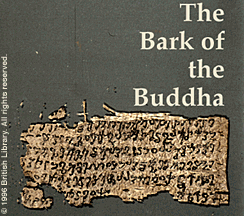

Salomon's time in London was running short. As he sat at his desk in the library, he read over and over a fragment that referred to the rhinoceros, trying to remember if he had ever seen a similar section in Buddhist literature from other languages.
On his final evening in London, he was staying at the home of a colleague, a former UW student who shared Salomon's scholarly interests. Unable to sleep, he found himself scanning the shelves in his colleague's personal library. Suddenly, his gaze fixed on a single volume that was a translation of The Rhinoceros Horn and Other Early Buddhist Poems, and he pulled it down. As he flipped through the pages, he found a passage that closely resembled the one he had found in the scrolls. It was from the "Sermon on the Rhinoceros' Horn"--translated from Pali, the language of southern India, from manuscripts many centuries later than the presumed date of the scrolls. By chance Salomon had found the link between the scrolls and the rest of Buddhist literature.
"I don't believe in fate or that things are destined to happen," he says. "But that experience convinced me that there was something in the texts worth pursuing."

As a result of his discovery, Salomon and his UW colleagues have special access to the Buddhist manuscripts. "The idea is not to hoard the texts, but to make them available as soon as possible in the most efficient and effective way," he explains. The lessons from the Dead Sea Scrolls project, in which the texts were guarded jealously and were not subject to review even by the general scholarly community, have been very much on the minds of those planning this research. Working with Salomon are Associate Professor Collett Cox, who specializes in Buddhist doctrine, philosophy and literature, and two graduate students, Tim Lenz and Jason Neelis.
The UW is providing Salomon and his colleagues with three high-powered computers, where they sit poring over digitized images of the scrolls, trying to decipher letters written down nearly 2,000 years ago on a medium not meant to last one tenth of that time. In fact, one theory about the scrolls is that they were worn-out versions of the text that had been recopied by monks onto new scrolls. The old texts, because they were holy documents, were put in clay vessels and buried in the monastery.
"Even when the letters are legible, the language is difficult to understand," he says. "The scrolls are written in Gandhari, but most of the documents in Gandhari prior to this find were civic documents or inscriptions. They don't provide us with much guidance in translating religious literature. Moreover, Gandhari itself from this period of history was not standardized. We know, for example, the word `and' can be spelled in at least six different ways."
The scrolls fill a major gap in the history of Buddhism. Although the Buddha lived in India, the religion nearly died out there after his death. The tradition survived elsewhere in Asia, and Buddha's teachings were translated into several languages--among them Pali, Tibetan and Chinese.
Many ancient trading and cultural exchanges took place two millennia ago in what was then northwest India, in the region called Gandhara, long recognized by scholars as an ancient center for Buddhism. The region, part of what is now northern Pakistan and eastern Afghanistan, contains the remains of many structures related to Buddhism, including elaborately sculpted stupas, tower-like domed structures of stone, sometimes three or four stories high, constructed to store fragments of the bones of the original Buddha. "But despite all the evidence of a thriving culture, scholars had wondered, `Where is the Gandharan literature?' Now we know that the texts in the British Library represent a substantial portion of the long-lost Buddhist canon," Salomon says.
Scholar Thrust into the Limelight with Discovery of
the Scrolls
Buddhist Doctrine from a
Non-Buddhist
Send a letter to the editor at columns@u.washington.edu.